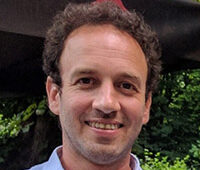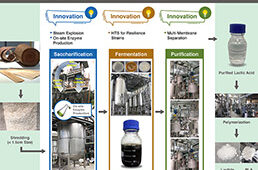These images show a single carbon nanotube before and after amplification, a process developed at Rice University seen as key in the development of armchair quantum wire. Such a wire would transmit electricity over great distances with virtually no loss. Image: Barron Lab/Rice University |
Rice University scientists have achieved a
pivotal breakthrough in the development of a cable that will make an efficient
electric grid of the future possible.
Armchair quantum wire (AQW) will be a weave of metallic nanotubes that can
carry electricity with negligible loss over long distances. It will be an ideal
replacement for the nation’s copper-based grid, which leaks electricity at an
estimated 5% per 100 miles of transmission, says Rice chemist Andrew R. Barron,
author of a paper about the latest step forward published online by Nano Letters.
A prime technical hurdle in the development of this “miracle cable,” Barron
says, is the manufacture of massive amounts of metallic single-walled carbon
nanotubes, dubbed armchairs for their unique shape. Armchairs are best for
carrying current, but can’t yet be made alone. They grow in batches with other
kinds of nanotubes and have to be separated out, which is a difficult process
given that a human hair is 50,000 times larger than a single nanotube.
Barron’s lab demonstrated a way to take small batches of individual nanotubes
and make them dramatically longer. Ideally, long armchair nanotubes could be
cut, re-seeded with catalyst, and re-grown indefinitely.
The paper was written by graduate student and first author Alvin Orbaek,
undergraduate student Andrew Owens and Barron, the Charles W. Duncan Jr.-Welch
Professor of Chemistry and a professor of materials science.
Amplification of nanotubes was seen as a key step toward the practical
manufacture of AQW by the late Rice professor, nanotechnology pioneer and Nobel
laureate Richard Smalley, who worked closely with Barron and Rice chemist James
Tour, the T.T. and W.F. Chao Chair in Chemistry as well as a professor of
mechanical engineering and materials science and of computer science, to lay out
a path for its development.
Barron charged Orbaek with the task of following through when he joined the
lab five years ago. “When I first heard about Rice
University, it was because of Rick Smalley
and carbon nanotubes,” says Orbaek, a native of Ireland. “He had a large
global presence with regard to nanotechnology, and that reached me.
“So I was delighted to come here and find I’d be working on nanotube
growth that was related to Smalley’s work.”
Orbaek says he hasn’t strayed far from Barron’s original direction, which
involved chemically attaching an iron/cobalt catalyst to the ends of nanotubes
and then fine-tuning the temperature and environment in which amplification
could occur.
“My group, with Smalley and Tour’s group, demonstrated you could do
this—but in the first demonstration, we got only one tube to grow out of hundreds
or thousands,” Barron says. Subsequent experiments raised the yield, but
tube growth was minimal. In other attempts, the catalyst would literally eat—or
“etch”—the nanotubes, he says.
Refining the process has taken years, but the payoff is clear because up to
90% of the nanotubes in a batch can now be amplified to significant lengths,
Barron says. The latest experiments focused on single-walled carbon nanotubes
of various chiralities, but the researchers feel the results would be as great,
and probably even better, with a batch of pristine armchairs.
The key was finding the right balance of temperatures, pressures, reaction
times, and catalyst ratios to promote growth and retard etching, Barron says.
While initial growth took place at 1,000 C, the researchers found the
amplification step required lowering the temperature by 200 degrees, in
addition to adjusting the chemistry to maximize the yield.
“What we’re getting to is that sweet spot where most of the nanotubes
grow and none of them etch,” Barron says.
Wade Adams, director of Rice’s Richard E. Smalley Institute for Nanoscale
Science and Technology and principal investigator on the AQW project, compares
the technique to making sourdough bread. “You make a little batch of pure
metallics and then amplify that tremendously to make a large amount. This is an
important increment in developing the science to make AQW.”
Adams notes eight Rice professors and
dozens of their students are working on aspects of AQW. “We know how to
spin nanotubes into fibers, and their properties are improving rapidly
too,” he says. “All this now has to come together in a grand program
to turn quantum wires into a product that will carry vast amounts of
electricity around the world.”
Barron and his team are continuing to fine-tune their process and hope that
by summer’s end they can begin amplifying armchair nanotubes with the goal of
making large quantities of pure metallics. “We’re always learning more
about the mechanisms by which nanotubes grow,” says Orbaek, who sees the
end game as the development of a single furnace to grow nanotubes from scratch,
cap them with new catalyst, amplify them, and put out a steady stream of fiber
for cables.
“What we’ve done is a baby step,” he says. “But it verifies
that, in the big picture, armchair quantum wire is technically feasible.”
Orbaek says he is thrilled to play a role in achieving amplification, which
Smalley recognized as necessary to his dream of an efficient energy grid that
would catalyze solutions to many of the world’s problems.
“I’d love to meet him now to say, ‘Hey, man, you were right,'” he
says.





